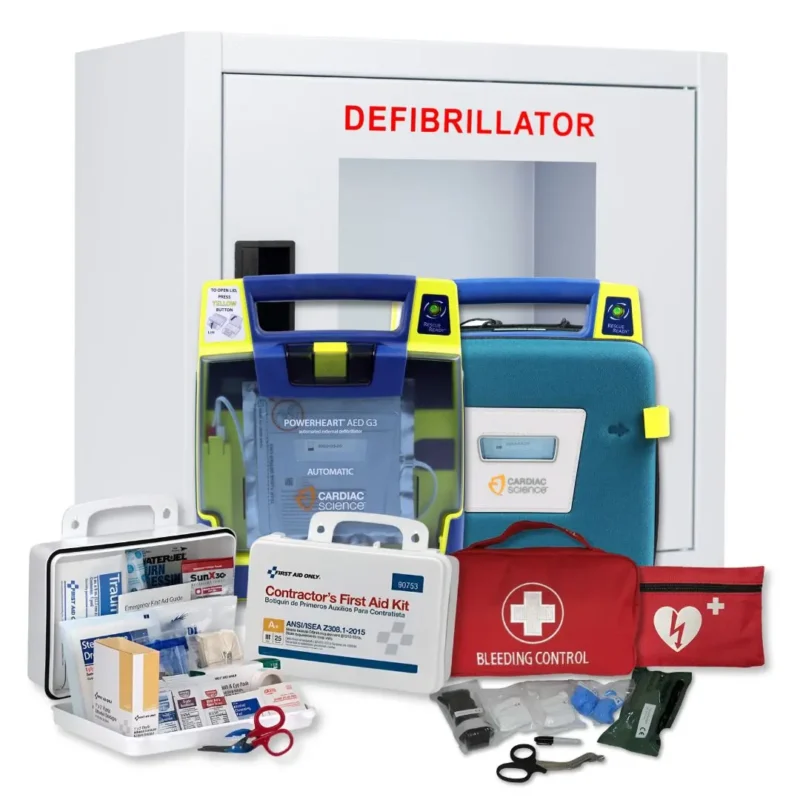No products in the cart.
AED's
AEDs and Fitness Trackers: Monitoring Heart Health with Technology
Technology has become an indispensable component of everyday life, offering solutions that improve our health, safety, and well-being. Two tools which have revolutionized heart care monitoring: Automated External Defibrillators (AEDs) and fitness trackers have revolutionized how we track heart health: Automated External Defibrillators (AEDs), designed to deliver lifesaving electric shocks in cases of sudden cardiac arrest (SCA), are more accessible than ever while fitness trackers have evolved from basic step counters into sophisticated devices capable of monitoring heart-related metrics – such as AEDs used as AEDs are changing how heart health monitoring.
This article details how AEDs and fitness tracker function, their purpose in monitoring heart health, and how these technologies interact together for enhanced overall well-being and safety.
Automated External Defibrillators (AEDs)

An Automated External Defibrillator (AED) is a portable medical device intended to treat sudden cardiac arrest (SCA), wherein the heart suddenly stops beating unexpectedly without warning. SCA can often be caused by irregular heart rhythms known as arrhythmias which restrict its ability to pump blood efficiently to essential organs – and can result in fatality within minutes if untreated immediately.
AEDs are user-friendly devices designed for anyone to operate without medical training. AEDs work by analyzing heart rhythm and, when necessary, administering an electrical shock to restore normal heart function if it becomes necessary – an invaluable ability in emergencies like gyms, airports, schools, and offices where timely restarting may save lives.
How AEDs Save Lives
A fitness tracker AED’s primary function is to correct life-threatening arrhythmias such as ventricular fibrillation (VF) or ventricular tachycardia (VT), which prevent the heart from pumping blood effectively and lead to sudden cardiac arrest. By administering electrical shock therapy through its AED device, AEDs help reset heart rhythms so it may function normally again and return to normal life function for its patient.
Successful AED use hinges heavily upon the time between cardiac arrest and defibrillation – each minute that passes without defibrillation decreases survival by about 10%, making public and private institution AED access essential in increasing chances of SCA survival rates.
Modern AEDs are designed to guide users through their rescue with audiovisual instructions that make the rescue process accessible even for those without medical training. Some advanced models even assess patient conditions automatically to determine whether shock treatment should occur, further simplifying rescue.
Fitness Trackers as Tools of Heart Health Monitoring
While AEDs play an essential part in emergency cardiac situations, fitness trackers play a unique yet equally vital role when it comes to monitoring cardiovascular health. Fitness trackers have evolved significantly in recent years to offer various features including heart rate tracking.
Modern fitness trackers use optical sensors to continuously measure heart rate throughout the day, providing users with insight into their resting heart rate, exercise-induced heart rate changes, and overall cardiovascular health. Some fitness trackers even come equipped with ECG (electrocardiogram) monitoring features which may detect arrhythmias or abnormal heart rhythms.
The Key Features of Fitness Trackers for Heart Health
Fitness tracker AED feature real-time heart rate monitoring capabilities that enable users to keep tabs on the activity of their heart at any point during the day, giving an accurate picture of its activity throughout. This feature can help identify patterns or changes that could indicate potential health concerns; when exercising, monitoring can ensure safe and efficient workouts within specific heart rate zones.
Resting Heart Rate
A lower resting heart rate indicates more efficient heart function; an unusually high resting heart rate could signal stress or other medical conditions that necessitate further examination of cardiovascular health. Fitness trackers offer useful insights into long-term heart wellness.
ECG Monitoring
Some advanced fitness trackers, like Apple Watch or Fitbit Sense, include ECG functionality for users. This feature allows individuals to take an electrocardiogram that measures heart electrical activity, helping identify abnormal heart rhythms such as atrial fibrillation (AFib). Early identification can lead to timely medical intervention and potentially avoid more serious heart conditions in future.
Heart Rate Variability
Heart Rate Variability (HRV) measures the variation between heartbeats to provide a measure of overall fitness and stress levels. A higher HRV typically indicates improved cardiovascular fitness as well as more adaptable nervous system function while lower readings could signify stress, fatigue or illness – fitness trackers offer users a useful way to monitor this metric so as to gauge recovery after exercising as well as manage stress more effectively.
AEDs and Fitness Trackers

Both AEDs and fitness tracker AEDs serve distinct roles, yet both contribute to improved heart health outcomes. Fitness trackers equip users with data they need for monitoring and improving daily heart health; AEDs offer vital emergency lifesaving assistance – together, these two systems create a comprehensive system of managing heart health management.
Fitness trackers can serve as early warning systems, notifying users to irregular heart rhythms or spikes in heart rate that require medical advice or lifestyle modifications to reduce cardiac risks. Should someone suffer an unexpected cardiac arrest, having access to an AED could make all the difference between life and death.
Additionally, fitness trackers now include emergency response features. The Apple Watch’s ECG feature can detect signs of atrial fibrillation and notify wearers to seek medical assistance immediately. Other devices come equipped with fall detection sensors which automatically contact emergency services if a fall happens and causes unresponsiveness – these features could increase survival odds when sudden cardiac arrest precedes falling incidents.
Technology’s Role in Preventive Heart Health
Preventive care is an integral component of heart health, and technology plays a crucial role in this aspect. Fitness trackers allow individuals to take proactive steps toward monitoring and improving their heart health. Through exercise tracking devices, they can track physical fitness progress while managing stress or improving sleep quality for maximum impactful heart care results. Fitness trackers keep users on the right path toward reaching these goals for improved cardiac well-being.
Fitness trackers help users become more mindful in their everyday activities. Features like monitoring heart rate during physical exercise can assist individuals in avoiding overexertion and lowering risks related to heart-related incidents; additionally, features, like guided breathing exercises or sleep tracking, can promote relaxation and recuperation—two essential aspects for maintaining heart health.
On the other hand, AEDs help communities, workplaces and public spaces prepare for any possible cardiac emergencies that might arise by having AEDs readily available – decreasing response time while improving survival chances.
Conclusion
Fitness tracker AEDs represent two sides of one coin in heart health technology. Fitness trackers give individuals tools they need to monitor their heart health regularly and detect potential issues early. AEDs on the other hand provide lifesaving intervention during sudden cardiac arrest incidents so immediate steps can be taken to save lives.
These technologies come together to both promote heart health and provide peace of mind. As more individuals recognize the significance of heart health, fitness trackers and AEDs will play a critical role in saving lives.






